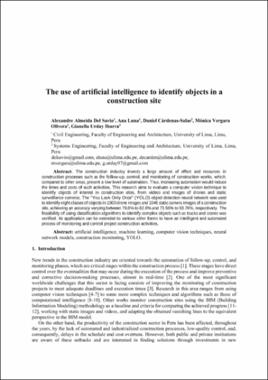Mostrar el registro sencillo del ítem
The use of artificial intelligence to identify objects in a construction site
| dc.contributor.author | Del Savio, Alexandre Almeida | |
| dc.contributor.author | Luna Torres, Ana Felícita | |
| dc.contributor.author | Cárdenas Salas, Daniel Enrique | |
| dc.contributor.author | Vergara Olivera, Mónica Alejandra | |
| dc.contributor.author | Urday Ibarra, Gianella Tania | |
| dc.contributor.other | Del Savio, Alexandre Almeida | |
| dc.contributor.other | Luna Torres, Ana Felícita | |
| dc.contributor.other | Cárdenas Salas, Daniel Enrique | |
| dc.contributor.other | Vergara Olivera, Mónica Alejandra | |
| dc.date.accessioned | 2022-01-26T22:59:40Z | |
| dc.date.issued | 2021 | |
| dc.identifier.citation | Almeida Del Savio, A., Luna, A., Cárdenas-Salas, D., Vergara Olivera, M. & Urday Ibarra, G. (2021). The use of artificial intelligence to identify objects in a construction site. International Conference on Artificial Intelligence and Energy System (ICAIES) in Virtual Mode, Jaipur, India. http://doi.org/10.26439/ulima.prep.14933 | es_PE |
| dc.identifier.uri | https://hdl.handle.net/20.500.12724/14933 | |
| dc.description | Artículo presentado en el International Conference on Artificial Intelligence and Energy System (ICAIES-2021) in Virtual Mode, llevada a cabo el 12 y 13 de junio del 2021. Los datos de investigación están disponibles en la siguiente dirección https://doi.org/10.26439/ulima.datasets.13359 | es_PE |
| dc.description.abstract | The construction industry invests a large amount of effort and resources in construction processes such as the follow-up, control, and monitoring of construction works, which, compared to other areas, present a low level of automation. Thus, increasing automation would reduce the times and costs of such activities. This research aims to evaluate a computer vision technique to identify objects of interest in construction sites, from videos and images of drones and static surveillance cameras. The "You Look Only Once" (YOLO) object detection neural network was used to identify eight classes of objects in 1000 drone images and 1046 static camera images of a construction site, achieving an accuracy varying between 78.8% to 82.8% and 73.56% to 93.76%, respectively. The feasibility of using classification algorithms to identify complex objects such as trucks and cranes was verified. Its application can be extended to various other forms to have an intelligent and automated process of monitoring and control project construction activities. | es_PE |
| dc.format | application/pdf | |
| dc.language.iso | eng | |
| dc.publisher | Universidad de Lima | |
| dc.relation.uri | https://doi.org/10.26439/ulima.datasets.13359 | |
| dc.rights | info:eu-repo/semantics/openAccess | * |
| dc.rights.uri | https://creativecommons.org/licenses/by-nc-sa/4.0/ | * |
| dc.source | Repositorio Institucional - Ulima | |
| dc.source | Universidad de Lima | |
| dc.subject | Artificial intelligence | es_PE |
| dc.subject | Machine learning | es_PE |
| dc.subject | Computer vision techniques | es_PE |
| dc.subject | Neural network models | es_PE |
| dc.subject | Construction monitoring | es_PE |
| dc.title | The use of artificial intelligence to identify objects in a construction site | es_PE |
| dc.type | info:eu-repo/semantics/conferenceObject | |
| dc.description.peer-review | Revisión por pares | es_PE |
| dc.publisher.country | PE | |
| dc.type.other | Artículo de conferencia | |
| dc.contributor.student | Urday Ibarra, Gianella Tania (Ingeniería de Sistemas) | |
| dc.identifier.event | International Conference on Artificial Intelligence and Energy System (ICAIES) | |
| dc.subject.ocde | https://purl.org/pe-repo/ocde/ford#2.01.01 | |
| dc.identifier.doi | http://doi.org/10.26439/ulima.prep.14933 |
Ficheros en el ítem
Este ítem aparece en la(s) siguiente(s) colección(ones)
-
Ingeniería Civil [11]



